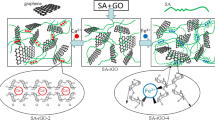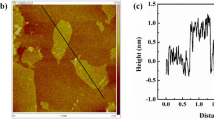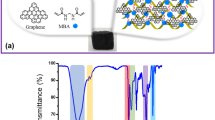Abstract
The multi-responsive ternary poly(N-isopropyl acrylamide) (PNIPAM)/ /sodium alginate (SA)/graphene oxide (GO) composite hydrogels were prepared. The influence of GO content on the microstructure and physical properties of the composite hydrogel was researched. The ternary composite hydrogels exhibited significantly larger mechanical strength and higher water uptake compared to binary PNIPAM/SA composite hydrogels. The effects of temperature, pH, and contact time on the adsorption capacity of rhodamine B (RB) for the PNIPAM/SA/GO ternary composite hydrogels were further investigated. The adsorption kinetic and isotherm for the adsorption behavior of the ternary composite hydrogel were well fitted with the pseudo-second-order kinetic model and Langmuir model, respectively. Besides, the PNIPAM/SA/GO ternary composite hydrogel could be easily removed from the dye solutions and reused without the obvious decrease of its performance. It indicated that the ternary composite hydrogel could serve as an effective adsorbent for the removal of organic pollutants.










Similar content being viewed by others
Data availability
All data generated or analyzed during this study are included in this published article.
References
Zhang H, Li X, He G et al (2013) Preparation of magnetic composite hollow microsphere and its adsorption capacity for basic dyes. Ind Eng Chem Res 52:16902–16910
Bakshi BR, Gutowski TG, Sekulic DP (2018) Claiming sustainability: requirements and challenges. ACS Sustainable Chem Eng 6:3632–3639
Heimer BW, Paap SM, Sasan K et al (2019) 110th Anniversary: industrial process water treatment and reuse enabled by selective ion exchange materials. Ind Eng Chem Res 58:14873–14879
Omer AM, Sadik WA, El-Demerdash AM et al (2021) Fabrication of semi-interpenetrated PVA/PAMPS hydrogel as a reusable adsorbent for cationic methylene blue dye: isotherms, kinetics and thermodynamics studies. Polym Bull 78:6649–6673
Maleki H, Bertola V (2019) TiO2 nanofilms on polymeric substrates for the photocatalytic degradation of methylene blue. ACS Appl Nano Mater 2:7237–7244
Sahu K, Bisht A, Kuriakose S, Mohapatra S (2020) Twodimensional CuO-ZnO nanohybrids with enhanced photocatalytic performance for removal of pollutants. J Phys Chem Solids 137:109223
Neoh CH, Noor ZZ, Mutamim NSA et al (2016) Green technology in wastewater treatment technologies: integration of membrane bioreactor with various wastewater treatment systems. Chem Eng J 283:582–594
Dehghani M, Nadeem H, Raghuwanshi VS et al (2020) ZnO/cellulose nanofiber composites for sustainable sunlightdriven dye degradation. ACS Appl Nano Mater 3:10284–10295
Mohamed NA, Al-Harby NF, Almarshed MS (2020) Enhancement of adsorption of Congo red dye onto novel antimicrobial trimellitic anhydride isothiocyanate-cross-linked chitosan hydrogels. Polym Bull 77:6135–6160
Xu H, Fang W, Xu L et al (2020) Batch preparation of CuO/ZnO-loaded nanofiber membranes for photocatalytic degradation of organic dyes. Langmuir 36:14189–14202
Atta A, Al-Lohedan H, Ezzat A et al (2017) Synthesis of zinc oxide nanocomposites using poly(ionic liquids) based on quaternary ammonium acrylamidomethyl propane sulfonate for water treatment. J Mol Liq 236:38–47
Ranjithkumar V, Sangeetha S, Vairam S (2014) Synthesis of magnetic activated carbon/α-Fe2O3nanocomposite and its application in the removal of acid yellow 17 dye from water. J Hazard Mater 273:127–135
Ranjbari E, Bazgir S, Shirazi MMA (2020) Needleless electrospinning of poly(acrylic acid) superabsorbent: fabrication, characterization and swelling behavior. Polym Test 84:106403
Natarajan S, Bajaj HC, Tayade RJ (2018) Recent advances based on the synergetic effect of adsorption for removal of dyes from waste water using photocatalytic process. J Environ Sci 65:201–222
Adnan MAM, Phoon BL, Julkapli NM (2020) Mitigation of pollutants by chitosan/metallic oxide photocatalyst: a review. J Cleaner Prod 261:121190
Weng Y, Zheng J, Zhang M (2021) Integration with MoO3 microrods as precursors for hierarchical polyaniline microtubes and composites for anionic dye removal in water treatment. New J Chem 45:14036–14041
Ye X, Xu Q, Xu J (2019) Oxidant-templating fabrication of pure polypyrrole hydrogel beads as a highly efficient dye adsorbent. RSC Adv 9:5895–5900
Cazetta AL, Pezoti O, Bedin KC et al (2016) Magnetic activated carbon derived from biomass waste by concurrent synthesis: efficient adsorbent for toxic dyes. ACS Sustainable Chem Eng 4:1058–1068
Tanaka Y, Gong JP, Osada Y (2005) Novel hydrogels with excellent mechanical performance. Prog Polym Sci 30:1–9
Zheng H, Lin N, He Y et al (2021) Self-healing, self-adhesive silk fibroin conductive hydrogel as a flexible strain sensor. ACS Appl Mater Interfaces 13:40013–40031
Takeno H, Inoguchi H, Hsieh WC (2020) Mechanical and structural properties of cellulose nanofiber/poly(vinyl alcohol) hydrogels cross-linked by a freezing/thawing method and borax. Cellulose 27:4373–4387
Wang F, Du H, Liu Y et al (2021) Elastic polypyrrole hydrogels reinforced by TEMPO-oxidized cellulose for supercapacitors. Synthetic Met 282:116952
Sikdar A, Deb SK, Gogoi A et al (2020) Polyaniline-graphene hydrogel hybrids via diffusion controlled surface polymerization for high performance supercapacitors. ACS Appl Nano Mater 3:12278–12287
Zhao Z, Wang H, Huang H et al (2021) Graphene oxide/polypyrrole/polyaniline composite hydrogel synthesized by vapor-liquid interfacial method for supercapacitors”. Colloids Surf A 626:127125
Hossain M, Afroz S, Islam MU et al (2021) Synthesis and characterization of polyvinyl alcohol/water-hyacinth (Eichhornia crassipes) based hydrogel by applying gamma radiation. J Polym Res 28:167
Zhang X, Liu D, Yang L (2015) Self-assembled three-dimensional graphene-based materials for dye adsorption and catalysis. J Mater Chem A 3:10031–10037
Zhang Z, Xiao F, Guo Y et al (2013) One-pot self-assembled three-dimensional TiO2-graphene hydrogel with improved adsorption capacities and photocatalytic and electrochemical activities. ACS Appl Mater Interfaces 5:2227–2233
Karim Z, Mathew AP, Grahn M et al (2014) Nanoporous membranes with cellulose nanocrystals as functional entity in chitosan: removal of dyes from water. Carbohydr Polym 112:668–676
Ou X, Yang X, Zheng J et al (2019) Free-standing graphene oxide-chitin nanocrystal composite membrane for dye adsorption and oil/water separation. ACS Sustainable Chem Eng 7:13379–13390
Li C, Yan Y, Zhang Q et al (2019) Adsorption of Cd2+ and Ni2+ from aqueous single-metal solutions on graphene oxide-chitosan-poly(vinyl alcohol) hydrogels. Langmuir 35:4481–4490
Zhang Y, Yu J, Ren K et al (2019) Thermosensitive hydrogels as scaffolds for cartilage tissue engineering. Biomacromol 20:1478–1492
Tavsanli B, Okay O (2019) Mechanically robust and stretchable silk/hyaluronic acid hydrogels. Carbohydr Polym 208:413–420
Gavel PK, Parmar HS, Tripathi V et al (2019) Investigations of anti-inflammatory activity of a peptide-based hydrogel using rat air pouch model. ACS Appl Mater Interfaces 11:2849–2859
Jing X, Mi H, Napiwocki BN et al (2017) Mussel-inspired electroactive chitosan/graphene oxide composite hydrogel with rapid self-healing and recovery behavior for tissue engineering. Carbon 125:557–570
She X, Sun P, Yu X et al (2014) Fabrication of 3D polypyrrole/graphene oxide composite hydrogels with high performance swelling properties. J Inorg Organomet Polym 24:884–889
Baruah S, Kumar S, Nayak B (2021) Optoelectronically suitable graphene oxide-decorated titanium oxide/polyaniline hybrid nanocomposites and their enhanced photocatalytic activity with methylene blue and rhodamine B dye. Polym Bull 78:1703–1720
He Y, Zhang N, Gong Q et al (2012) Alginate/graphene oxide fibers with enhanced mechanical strength prepared by wet spinning. Carbohydr Polym 88:1100–1108
Xiao D, He M, Liu Y et al (2020) Strong alginate/reduced graphene oxide composite hydrogels with enhanced dye adsorption performance. Polym Bull 77:6609–6623
Cui W, Ji J, Cai YF et al (2015) Robust, anti-fatigue, and self-healing graphene oxide/hydrophobically associated composite hydrogels and their use as recyclable adsorbents for dye wastewater treatment. J Mater Chem A 3:17445–17458
Lo C, Zhu D, Jiang H (2011) An infrared-light responsive graphene-oxide incorporated poly(N-isopropylacrylamide) hydrogel nanocomposite. Soft Matter 7:5604–5609
Li Z, Shen J, Ma H et al (2012) Preparation and characterization of pH- and temperature-responsive hydrogels with surface-functionalized graphene oxide as the crosslinker. Soft Matter 8:3139–3145
Hummers WS, Offeman RE (1958) Preparation of graphitic oxide. J Am Chem Soc 80:1339
Ai S, Chen Y, Liu Y et al (2018) Facile synthesis of nitrogen-doped graphene aerogels for electrochemical detection of dopamine. Solid State Sci 86:6–11
Han X, Liu Y, Xiong L et al (2019) Facile Assembly of polyaniline/graphene oxide composite hydrogels as adsorbent for Cr(VI) removal. Polym Composites 40:E1777–E1785
Xu Y, Wu Q, Sun Y et al (2010) Three-dimensional self-assembly of graphene oxide and DNA into multifunctional hydrogels. ACS Nano 4:7358–7362
Balandin AA, Ghosh S, Bao W et al (2008) Superior thermal conductivity of single-layer graphene. Nano Lett 8:902–907
Shen J, Yan B, Li T et al (2012) Mechanical, thermal and swelling properties of poly(acrylic acid)–graphene oxide composite hydrogels. Soft Matter 8:1831–1836
Liu R, Liang S, Tang XZ et al (2012) Tough and highly stretchable graphene oxide/polyacrylamide nanocomposite hydrogels. J Mater Chem 22:14160–14167
Medhekar NV, Ramasubramaniam A, Ruoff RS et al (2010) Hydrogen bond networks in graphene oxide composite paper: structure and mechanical properties. ACS Nano 4:2300–2306
Ma JH, Xu YJ, Zhang QS et al (2007) Preparation and characterization of pH- and temperature-responsive semi-IPN hydrogels of carboxymethyl chitosan with poly (N-isopropyl acrylamide) crosslinked by clay. Colloid Polym Sci 285:479–484
Guo X, Fei GT, Su H et al (2011) Synthesis of polyaniline micro/nanospheres by a copper(II)-catalyzed self-assembly method with superior adsorption capacity of organic dye from aqueous solution. J Mater Chem 21:8618–8625
Tang T, Goossens K, Lu SJ et al (2020) Agar-reduced graphene oxide selectively adsorbs organic dyes and strengthens double-network hydrogels. RSC Adv 10:29287–29295
Ramesha GK, Kumara AV, Muralidhara HB et al (2011) Graphene and graphene oxide as effective adsorbents toward anionic and cationic dyes. J Colloid Interface Sci 361:270–277
Sun HM, Cao LY, Lu LH (2011) Magnetite/reduced graphene oxide nanocomposites: one step solvothermal synthesis and use as a novel platform for removal of dye pollutants. Nano Res 4:550–562
Fan J, Shi Z, Lian M et al (2013) Mechanically strong graphene oxide/sodium alginate/polyacrylamide nanocomposite hydrogel with improved dye adsorption capacity. J Mater Chem A 1:7433–7443
Sui ZY, Cui Y, Zhu JH et al (2013) Preparation of three dimensional graphene oxide-polyethylenimine porous materials as dye and gas adsorbents. ACS Appl Mater Interfaces 5:9172–9179
Geng Z, Lin Y, Yu X et al (2012) Highly efficient dye adsorption and removal: a functional hybrid of reduced graphene oxide-Fe3O4 nanoparticles as an easily regenerative adsorbent. J Mater Chem 22:3527–3535
Chen Y, Dai G, Gao Q (2019) Starch Nanoparticles−graphene aerogels with high supercapacitor performance and efficient adsorption. ACS Sustainable Chem Eng 7:14064–14073
Luo J, Lai J, Zhang N et al (2016) Tannic acid induced self-assembly of three-dimensional graphene with good adsorption and antibacterial properties. ACS Sustainable Chem Eng 4:1404–1413
Tiwari JN, Mahesh K, Le NH et al (2013) Reduced graphene oxide-based hydrogels for the efficient capture of dye pollutants from aqueous solutions. Carbon 56:173–182
Acknowledgements
The work was supported by Training Programs of Innovation and Entrepreneurship for Undergraduates, Graduate Innovative Fund of Wuhan Institute of Technology, Natural Science Foundation of Hubei Province (2021CFB507, 2021CFB169), the Hubei Provincial Department of Education Science and Technology Research program (B2021098), and the Open Project of Key Laboratory of Green Chemical Process of Ministry of Education (GCX202107).
Author information
Authors and Affiliations
Corresponding authors
Ethics declarations
Conflict of interest
The authors declare no conflict of interest.
Additional information
Publisher's Note
Springer Nature remains neutral with regard to jurisdictional claims in published maps and institutional affiliations.
Supplementary Information
Below is the link to the electronic supplementary material.
Rights and permissions
Springer Nature or its licensor (e.g. a society or other partner) holds exclusive rights to this article under a publishing agreement with the author(s) or other rightsholder(s); author self-archiving of the accepted manuscript version of this article is solely governed by the terms of such publishing agreement and applicable law.
About this article
Cite this article
Zhang, Y., Yang, F., Huang, H. et al. Synthesis and characterization of multi-responsive poly(N-isopropylacrylamide)-sodium alginate-graphene oxide composite hydrogels. Polym. Bull. 80, 10825–10842 (2023). https://doi.org/10.1007/s00289-022-04581-9
Received:
Revised:
Accepted:
Published:
Issue Date:
DOI: https://doi.org/10.1007/s00289-022-04581-9




